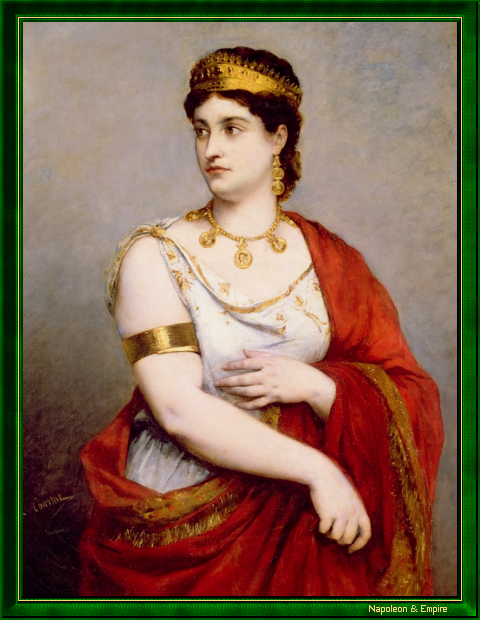Mademoiselle George
Pronunciation:

Marguerite-Joséphine Weimer was born on February 23, 1787, at 6 rue Saint-Patrice, Bayeux. Her parents, Georges Weimer and Marie Verteuil, both belonged to theatrical circles. Her father was soon to run the Amiens theater, while her mother was the aunt of a secretary at the Comédie française, and played the role of soubrette herself.
In such an environment, it was only natural for little Marguerite-Joséphine to take to the stage. She began her career at the age of five and, just a few years later, during performances of Phèdre (Jean Racine) and Didon (Jean-Jacques Lefranc de Pompignan), in which she played the lead role, attracted the interest of the most illustrious tragedienne of the time, Mademoiselle Raucourt. Raucourt recruited her for the Comédie-française before training her herself (under the inquisitive eye of Marguerite's mother, as Raucourt "enjoyed" a reputation for her morals that was as disturbing as it was admitting).
Mademoiselle George (Marguerite-Joséphine had taken her father's first name as a pseudonym) made her debut on November 29, 1802, as Clytemnestre in Racine's Iphigénie en Aulide. Success was immediate. Her beauty, voice and diction were also praised. Her subsequent performances only enhanced her reputation.
Already the mistress of Lucien Bonaparte, then of Prince Sappia, who offered her an apartment and his furniture, she became the mistress of the First Consul Napoleon Bonaparte. There was nothing romantic about the romance: the head of state simply sent a valet to summon the actress after a performance of Andromaque, and told her she could come without changing. She'll undress on the spot! Mademoiselle Georges complied, arriving at the Palais de Saint-Cloud at half-past midnight and leaving at six in the morning. The affair ended, by the actress's own admission, before the proclamation of the Empire: Il m'a quittée pour se faire empereur (He left me to become emperor)
, she said.
The jealousy of a rival, Mademoiselle Duchesnois, backed by Empress Josephine de Beauharnais, led to the formation of two antagonistic coteries: the Georgiens and the Carcassiens (so baptized by the followers of Mademoiselle Georges to denigrate the thinness of her competitor). In the theatre-français, the performances in which both actresses take part turn into pugilistic brawls. Eventually, however, Mademoiselle George established her superiority in the role of Phèdre, her rival's hobbyhorse until then. This victory, recognized even by the Carcassians, enabled her to establish herself in all the queenly roles of the repertoire.
In 1804, Marguerite-Joséphine became a half-share member of the Comédie française (the other half going to Mademoiselle Duchenois by grace of Empress Joséphine). She successfully created several roles in works that did not go down in history, while continuing to shine in the classical repertoire (Corneille and Racine).
In 1808, she abruptly left Paris and the Comédie-française for Russia, perhaps at the instigation of Charles-Maurice de Talleyrand-Périgord, who wanted to see her seduce Tsar Alexander I, or more simply as a result of a quarrel with the intendant of the theaters, a notorious supporter of her rival. The enthusiasm she aroused, first at Peterhof, then in St. Petersburg, was without precedent and would continue throughout her stay. The Tsar himself got out of his carriage to greet her when he passed the magnificent carriage in which she was traveling. For the actress's remuneration and lifestyle were commensurate with her fame.
In September 1808, at the Congress of Erfurt, several French plays (Cinna, Britannicus, Iphigénie en Aulide, La Mort de César...) were performed before an audience of sovereigns: Napoleon, Alexander I, the King and Queen of Westphalia, the King of Saxony, and those of Württemberg and Bavaria. Mademoiselle George is frequently mentioned among the actors, but there is no evidence of her presence.
Marguerite-Joséphine Weimer tried in vain to leave Russia before the French entered the country. She had to wait until 1813 for permission. She made her way to Stockholm, where she was received with honors by the Crown Prince of Sweden, the French general Jean-Baptiste Bernadotte. Her path crossed that of Madame de Staël-Holstein, then in exile with her husband's family. Mademoiselle George left the city in June, carrying a letter from Bernadotte to Jérôme Bonaparte, King of Westphalia, which she passed on to him before setting off for Dresden, where Napoleon was at the time.
Until August 10, 1813, as long as the Pleiswitz armistice, which had interrupted hostilities between France and the Sixth Coalition since June 4, lasted, fifty theatrical performances were organized in the Saxon capital by the comédiens du Français. Talma, who was absent since the Emperor had only commissioned the troupe's comic roles, was urgently recalled from Paris to star in the tragedies with Mademoiselle George. Almost every day, Mademoiselle George and her comrades were invited to lunch by Napoleon. On August 11, the actors received orders to return to Paris.
On September 20, Mademoiselle George resumed her position at the Comédie-française. By express order of the Emperor, she returned as a full member, erasing her absence. Success crowned her appearances once again.
The fall of the Empire distressed her, and her devotion to the Emperor earned her a few problems at the Comédie-française. However, she enthusiastically welcomed Napoleon's return from Elba and unsuccessfully demanded the privilege of accompanying him to St. Helena. This ill-timed Bonapartism led to her expulsion from the Maison de Molière (May 8, 1815).
From 1816 to 1821, Mademoiselle George performed on the great stages of the provinces, before King Louis XVIII brought her back to Paris. She starred at the Odéon until 1827, after which she took part in various national and international tours, which took her as far as London and Amsterdam. The organizer was her new lover, Charles-Jean Harel.
Marguerite-Joséphine returned to Paris in 1829, where she became the chosen interpreter of the nascent Romantic drama. First at the Odéon, then at the Théâtre de la Porte Saint-Martin, Alfred de Vigny (La Maréchale d'Ancre), Alexandre Dumas (La Tour de Nesle) and Victor Hugo (Lucrère Borgia, Marie Tudor), as well as a number of authors whose names are now forgotten, found in her an ambassador of choice. However, she was unable to avoid the downfall of some of these mediocre new works. What's more, from 1833 onwards, the actress's beauty began to fade: she began to get stale, as a certain Parisian press was quick to point out.
So when Harel, who ran the Porte Saint-Martin theater, found himself ruined by the banning of two of the works in his repertoire (including Balzac's Vautrin), Mademoiselle Georges decided to take to the road again with him (1840). These new tours took her first to the provinces, then to Italy, Austria and Russia (Crimea, then St. Petersburg), where she enjoyed the same success as before.
Her last years of activity saw her triumph over a new rival, Rachel Félix, whom she confronted in a singular theatrical joust. She then returned to service at the Odéon, where her success continued unabated - despite her obesity, which took on cartoonish dimensions - at the Théâtre de la Gaîté and the Théâtre de la Porte Saint-Martin. Her partners were Marie Dorval and the great Frédéric Lemaître.
In 1847, Marguerite-Joséphine Weimer tried unsuccessfully to found a tragedy class. After her retirement (May 1849), she became an inspector at the Conservatoire. She still found the strength to appear on stage from time to time, at the Comédie-française and finally at the Odéon, where she gave a final performance on July 3, 1855, the program of which has not been preserved.
These final efforts were aimed at balancing a financial situation that became increasingly difficult during the actress's last years. Her home, 31 rue du Ranelagh, on the border of Auteuil and Passy, in the 16th arrondissement of Paris, was a slum. She spent her time there writing Memoirs, which she was never able to complete, and in which she generally displayed a rare sincerity, except when it came to Napoleon, to whom she devoted a dazzled cult.
Marguerite-Joséphine Weimer died at home on January 11, 1867, of pulmonary congestion. She is buried in the Père-Lachaise cemetery, in the IXth division . Members of the Comédie-française contributed to the funeral expenses. Alexandre Dumas holds one of the stove cords.
Portrait of Mademoiselle George, painted by Louis-Joseph Courtat (Paris 1847 - Paris 1909)

Mademoiselle George shares her vault with Charles-Jean Harel, who was her long-time lover and friend.
Victor Hugo, Alexandre Dumas Père and Théophile Gautier considered her the best tragedian of her time.